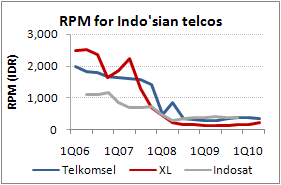|
But we need to remember that ‘everything is good as long as it is in the right measures'. So how much competition is good? At some point, when it gets too intense, competitors start to bleed. This is what has happened to the Indian telecom sector. With 15 operators operating competing networks, they are willing to do anything to woo the subscriber. This started from offering ridiculously low tariffs and extended to offering free minutes; anything that would get the subscriber to come on their network. The intensity of competition is visible in the rate per minute (RPM) for the leading telecom operators in the country that has trended downwards.
 |
Let us take the example of Indonesian telecoms to understand competition in telecom markets better. Indonesia has 3 major telecom operators - Telkom Indonesia, XL Axiata and Indosat. Telkom Indonesia has mobile operations through its 100% subsidiary Telkomsel. In FY07, XL started slashing tariffs to gain subscriber share. As a result, the other operators had to follow suit.
 |  |
This led to a sharp decline in profitability for these operators. Their EBITDA (Earnings before Interest, Tax, Depreciation & Amortization) declined in line with the decline in tariffs.
However, due to the effect of elasticity, minutes of usage (MOU) started going up as prices came down and mobile phones became more affordable for the consumers.
 |
As a result, the operators started experiencing network congestion wherein their networks could just not carry any incremental minutes. While they were expanding their network capacities, the rate of expansion was much slower than the rate of increase in usage. As a result, the operators were faced with the dilemma of either continuing with low tariffs or try and increase tariffs to stabilize usage. The tariffs then started to stabilize and have started to inch upwards since the past few quarters. Hence the cut throat competition came to an end.
Coming to the case of India, the situation is slightly different. While operators have slashed tariffs, there is no major capacity constraint as of now. This is because the new operators are rolling out their networks while the incumbents are expanding their networks. So the question that comes into mind is - Will this never end?
There is no clear answer, but it has become economically unviable for operators to slash their rates further. EBITDA margins for the incumbents (existing companies) have come down and the new operators are still bleeding.
 |  |
The only solution in sight for competition in Indian telecoms to ease off appears to be consolidation in the sector. While TRAI has given some recommendations to boost mergers and acquisition activity in the sector, none of the players appear too keen on it at the moment. In time, this should ease but till then this competitive bloodshed is expected to continue.





